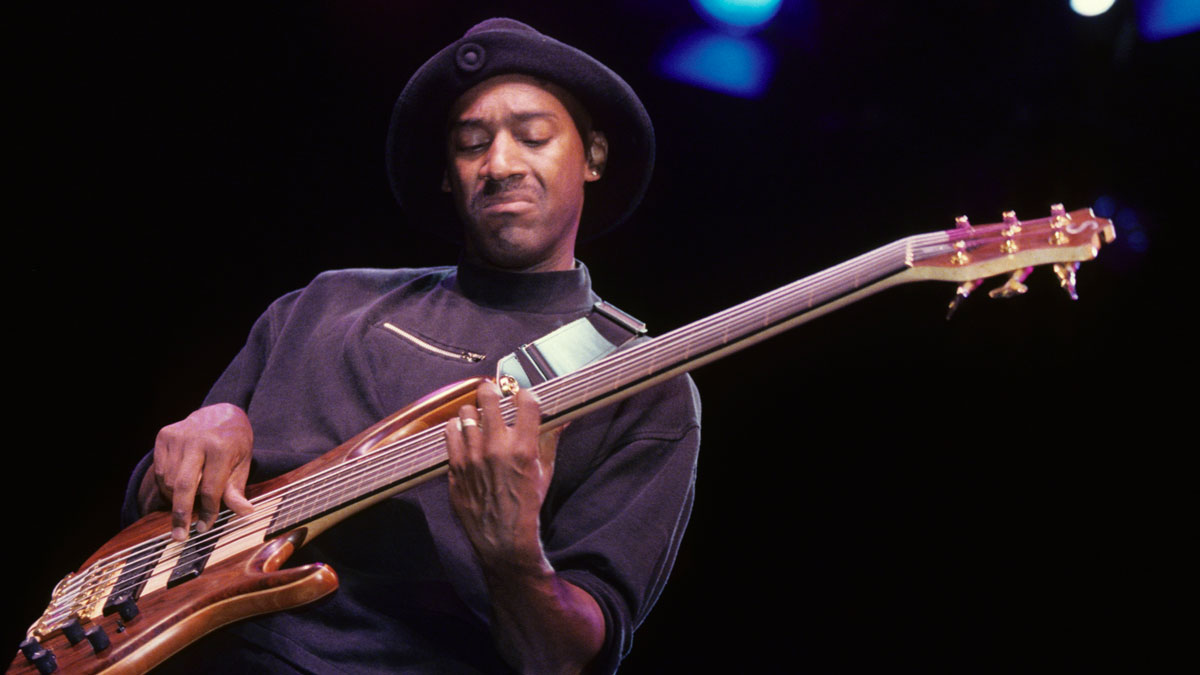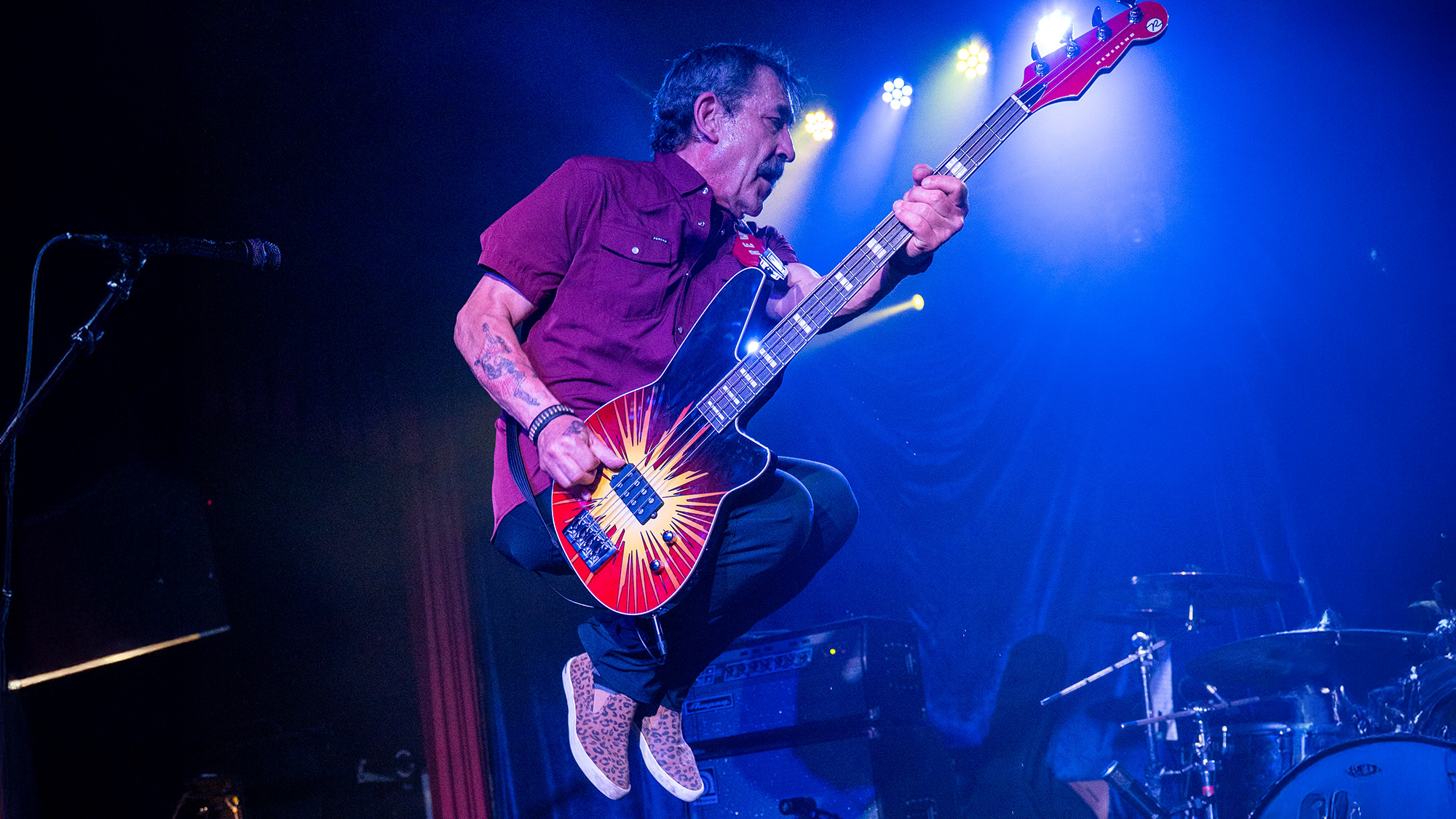A quick history of the fretless bass
We take you for a stroll through the strange territory of the fretless bass, where fingers glide and chords slide…

It’s every bassist’s nightmare. Tossing and turning in the middle of the night, you dream that you’re on stage, bass in hand, on the point of performing to an audience of people you want to impress. Trying not to look scared, you reach your fretting hand to play the first note, feeling for the comforting metal ridge of the fret you want. But to your horror, there are no frets — your hand slides meaninglessly down the neck, with nothing to hold it back. You try again. And again. But there’s nothing to tell you where you’re going.
Welcome to reality — in this case, the world of the fretless bass, where even bassists who have been playing standard fretted instruments for decades are reduced to snivelling weaklings by the mere sight of that strangely smooth, smug-looking fingerboard. Why would anyone want to remove those useful bits of wire, you may well wonder? After all, the first thing they told you when you started playing bass as a spotty teenager was “Press the string against the fretboard a bit to the left of the fret you want and it’ll be in tune. Press harder. Harder!” Well, you mused as you sucked your blistered fingertips, it may well hurt but at least you know the note is going to be in tune if you hold it vaguely left of target.
Appropriately, perhaps, the origins of this slinky, somewhat leftfield beast are shrouded in uncertainty. One theory has it, as you’ll know if you’re even slightly informed of bass guitar history, that this frankly eccentric instrument was the invention of bass pioneer Jaco Pastorius. Always an experimental innovator, Jaco had honed his chops to impressive levels when he purchased a 1962 Fender Jazz to use in South Florida club gigs and teaching sessions. As the story goes, in 1969 or 1970 he decided to try for a new sound and removed the frets, probably with a pair of pliers, before painting the grooves and the fretboard with a layer (or more likely, multiple layers) of marine epoxy, the super-tough varnish used to coat the hulls of boats. Using the hard surface to produce his trademark ‘singing’ fretless sound, Jaco slapped and popped his way to the top and the rest is history.
Or is it? Intriguingly, it seems that no-one actually knows for a fact when the first electric bass was actually defretted. However, the most likely theory is that the earliest fretless player to receive much widespread attention was Bill Wyman of the Rolling Stones, who played a home-made fretless as early as 1961, when Pastorius was only 10 years old. It began life as a standard fretted instrument, as the laconic four-stringer revealed in an interview some years ago: "I was playing in an R&B band in 1961 when I bought [the bass] from this guy our drummer knew. Before that I'd been playing bass on the bottom two strings of a detuned guitar, so I was glad to finally have a 'real' bass. Unfortunately, it was bloody horrible!… it rattled with every note because the frets were so worn. I figured I'd just pull out all the frets and put in new ones when I could afford some. But when I pulled 'em out, it suddenly sounded really good! So I never put frets back in, and I think it was the first fretless electric ever. I used it on every Stones album and many of the singles up to 1975. Even without an amp, it sounds wonderful — it's got the sound."
A few years passed before the fretless bass gained much commercial currency, but the profile of the instrument received a boost in 1965 when Ampeg, the company known nowadays for amps rather than instruments, began to produce a production-line fretless, the AUB1. Shortly afterwards, respected players such as Rick Danko (the Band), bassist Dan ‘Freebo’ Friedberg (Bonnie Raitt) and Rand Forbes (the United States Of America) were seen playing fretless instruments. Others such as James Brown’s bass player Bernard Odum (who Jaco cited as an influence) and Donnie Troiano, four-stringer with a Canadian band called the Mandela, can claim to have been at the vanguard of the new style.
But perhaps the search for the very first fretless player is futile. After all, it was certainly Pastorius who popularized the fretless bass, even if he didn’t invent it. And the man himself may have been playing word games when he told BBC interviewer Clive Williamson in 1978: “So I'm the first guy to be using a fretless, is actually what it boils down to, and then more, because I'm the first to really get down and play it, because other guys cannot play it in tune, y'know?” Did he mean that he was the first player to play the fretless accurately, rather than being the very first player of all? We will never know. But we can listen and marvel to his early playing, and enjoy his honesty. This was, let us not forget, a man who used to dip his fingers in fried chicken grease before performing, to give his playing an added dexterous touch.
However it developed, the instrument we are left with all those years later is a unique creature. No other machine can produce sounds which are so often described as ‘singing’, ‘purring’, ‘humming’ and ‘ringing’. But this array of mellifluous notes doesn’t come cheaply: even those who have mastered the fretless to moderate levels of proficiency have been obliged to spend many hundreds of hours on techniques which fretted players either take for granted or simply do not require. For example, one of Jaco’s most frequently-repeated assertions was that a fretless player needs to ‘feel’ as much as ‘hear’ the sound he or she is making. This is a matter of sensing the frequency of the note as much as simply noticing it, which is an approach that requires subtlety and self-awareness. It’s perhaps for this reason that the fretless is regarded as more sensuous than its fretted counterpart.
All the latest guitar news, interviews, lessons, reviews, deals and more, direct to your inbox!
Another obvious difference between fretted and fretless approaches is, of course, that the player can slide between notes — or chords — far more smoothly and accurately than if frets were in the way, forcing the note to drop by a tone or semitone every time the fretting fingers slid past a fret. Gliding at an even speed down the neck requires accuracy — and seasoned players will often refer to ‘caressing’ the notes from the bass for this reason. Considerable fretting force — and control over the degree of that force — is also essential: a successful glissando is most likely to occur, for example, if a bassist has managed to maintain absolutely equal finger pressure against the neck from origin to destination. This applies to harmonics too: trapping one or more against the neck immediately after the string is plucked, and sliding one or more up or down, is a great way to add texture to a phrase. Ever worried about this stuff on a fretted bass? Didn’t think so.
So much for the instructions. But where can we go to see fretless brilliance in action? Apart from Pastorius and the aforementioned pioneers, the fretless apprentice should spend some time studying the fearsome skills of Jack Bruce, who in his latter years switched over almost exclusively to fretless. Famously a devotee of the Warwick Thumb bass (whose body he helped its makers to redesign a few years ago), it’s perhaps no surprise that the ex-Cream member started his life in the four-string world as a double bass player. Asked why he plucked the strings with such force, he replied: “I use double bass techniques, and I still play that way, even on fretless. It’s a bit peculiar, but it also comes from playing a veena, which is a classical Indian instrument. I studied that in the 60s, and have actually started studying it again… I thought I had kind of a unique thing, but when I met James Jamerson, I discovered that he was known as 'the hook', because he also used mostly his index finger, but of course you use your second and third fingers on occasion. But he was interested in this veena technique I’d developed for playing very fast passages… having been a double-bass player is an obvious asset.”
Another familiar fretless bassist is the renowned session player Pino Palladino, who started his musical career as a classical guitarist but switched to bass at the age of 17. It only took him a year before he decided to move to fretless, and by his early 20s he was playing in funk and R&B bands. This led to a gig with ex-Squeeze keyboard player Jools Holland's band, the Millionaires, which in turn brought him to the attention of early-80s pop and electro stars such as Gary Numan and Paul Young. In 1983 the latter musician recorded the song for which Pino will forever remain most well-known: a cover of Marvin Gaye’s 1963 hit Wherever I Lay My Hat. Palladino opened the song with an ethereal, melodic bass part that perfectly underpinned Young’s soulful vocal, without the need for percussion or other accompaniment until a whole intro, verse and chorus had passed. Later in the song Pino can be heard introducing a subtle slap and pop, as well as a few medium-register fills, while managing to maintain the groove with perfect awareness. All aspiring fretless players should study this bass-line: the fact that Palladino was asked to step into the considerable boots of the late John Entwistle just before a Who tour in 2002 speaks volumes. Well, could you have done it?
More contemporary than Bruce and as fêted as Palladino is Gordon ‘Sting’ Sumner, whose phenomenal success as a singer, songwriter, campaigner and media figure tends to obscure his awe-inspiring talents on the fretless. His early recordings as frontman with the Police were typified by the twin obsessions of the 1980s post-punk bass player — a churning chorus pedal and an obsession with reggae bass-lines. However, the genius behind the spiraling, super-economical bass parts in ‘Walking On The Moon’ (forever Sting’s best-known bass riff) and ‘Message In A Bottle’ (in which, at points, only his succinct playing and a rimshot keep the song rolling) is evident for all to see. His finest moment? Perhaps ‘Spirits In The Material World’, where the repeated bass motif running through the verse is made up of a slippery cluster of sixteenths and an expertly unselfish rest. Sting’s later career embraced jazz and world music and, while the stadium-goers and coffee-table owners of the globe opened their arms to him, nothing he has done on the bass in recent years matches up to the simple excellence of that early playing.
But the most memorable fretless player of recent times might well be Primus frontman Les Claypool, whose unearthly playing skills provide his band with all the funk, metal, jazz and rock licks they can take, and more. One of the few players to master tapping, slapping and even tremolo-powered divebombing on a bass - and a fretless bass at that - Claypool honed his style by listening to Stanley Clarke and Larry Graham. Equally fond of heavy metal (he famously failed the audition for Cliff Burton’s spot in Metallica for being too flash), he regularly namechecks Rush bassist Geddy Lee as his greatest influence. This goes as far as attaching a bit of wood with Lee’s signature on it to the headstock of the bizarre instrument he uses, a Carl Thompson creation called the Rainbow Bass. Made of strips of walnut, curly maple, padauk, purple heart, ebony and cocobolo glued in a vertical stripe pattern, the Rainbow comes in several configurations including four- and six-string fretted and fretless models and stands out from the crowd thanks to the weird, muscular wooden scroll which functions as its top horn.
So where does all this leave us? Maybe with the knowledge that the fretless bass is as weird and wonderful as anything in the world of its fretted counterpart; with some idea of how to go about playing this subtle, responsive instrument; and — perhaps — with the determination to give a fretless bass a try. There are more lovers of the fretless out there than you think — and they, like Bruce, Palladino, Sting and Claypool, know what rewards are to be had from playing one. Remember — with a little courage and application, the nightmare of fret-loss need never disturb your sleep.
Bass Player is the world’s most comprehensive, trusted and insightful bass publication for passionate bassists and active musicians of all ages. Whatever your ability, BP has the interviews, reviews and lessons that will make you a better bass player. We go behind the scenes with bass manufacturers, ask a stellar crew of bass players for their advice, and bring you insights into pretty much every style of bass playing that exists, from reggae to jazz to metal and beyond. The gear we review ranges from the affordable to the upmarket and we maximise the opportunity to evolve our playing with the best teachers on the planet.

